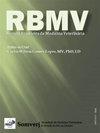Hematological and biochemical aspects of cats naturally infected with feline immunodeficiency virus and feline leukemia
Q4 Veterinary
引用次数: 3
Abstract
Considering the importance and severity of feline immunodeficiency virus (FIV) and feline leukemia virus (FeLV) infections, information on laboratory abnormalities can determine the prognosis of infected cats. This study aimed to determine the laboratory alterations of domiciled asymptomatics cats naturally infected by FIV and/or FeLV in Northeastern Brazil. Blood samples from 200 cats were evaluated by nested-PCR and commercial immunochromatographic test for diagnosis of these infections. Complete blood count (CBC) and serum biochemistry analyses were performed to evaluate laboratory abnormalities. CBC and biochemical values of cats tested positive for FIV and/or FeLV were tabulated for the presence or absence of changes and analyzed using the chi-square test with Yates correction or Fisher’s exact test for each variable, with a confidence interval of 95%. The total frequency was 6% (12/200) and 3% (6/200) for FIV and FeLV, respectively. The presence of hyperbilirubinemia (total, direct, and indirect) was the only change observed in cats positive for FIV compared to FIV-negative controls (p<0.05). We believe that laboratory changes compatible with immunosuppressive conditions should be more frequent in FIV/FeLV positive cats that already present clinical signs of the disease.自然感染猫免疫缺陷病毒和猫白血病的猫的血液学和生化方面
考虑到猫免疫缺陷病毒(FIV)和猫白血病病毒(FeLV)感染的重要性和严重性,实验室异常信息可以决定受感染猫的预后。本研究旨在确定巴西东北部自然感染FIV和/或FeLV的定居无症状猫的实验室变化。通过套式聚合酶链式反应和商业免疫层析检测对200只猫的血液样本进行评估,以诊断这些感染。进行全血细胞计数(CBC)和血清生物化学分析以评估实验室异常。FIV和/或FeLV检测呈阳性的猫的CBC和生化值被制成表格,以确定是否存在变化,并使用卡方检验和Yates校正或Fisher精确检验对每个变量进行分析,置信区间为95%。FIV和FeLV的总频率分别为6%(12/200)和3%(6/200)。与FIV阴性对照组相比,在FIV阳性猫中观察到的唯一变化是高胆红素血症(总的、直接的和间接的)。我们认为,在已经出现疾病临床症状的FIV/FeLV阳性猫中,与免疫抑制条件兼容的实验室变化应该更频繁。
本文章由计算机程序翻译,如有差异,请以英文原文为准。
求助全文
约1分钟内获得全文
求助全文
来源期刊
CiteScore
0.80
自引率
0.00%
发文量
34
审稿时长
>12 weeks
期刊介绍:
The Brazilian Journal of Veterinary Medicine was launched in 1979 as the official scientific periodical of the Sociedade de Medicina Veterinária do Estado do Rio de Janeiro (SOMVERJ). It is recognized by the Sociedade Brasileira de Medicina Veterinária (SBMV) and the Conselho Regional de Medicina Veterinária do Estado do Rio de Janeiro (CRMV-RJ).

 求助内容:
求助内容: 应助结果提醒方式:
应助结果提醒方式:


